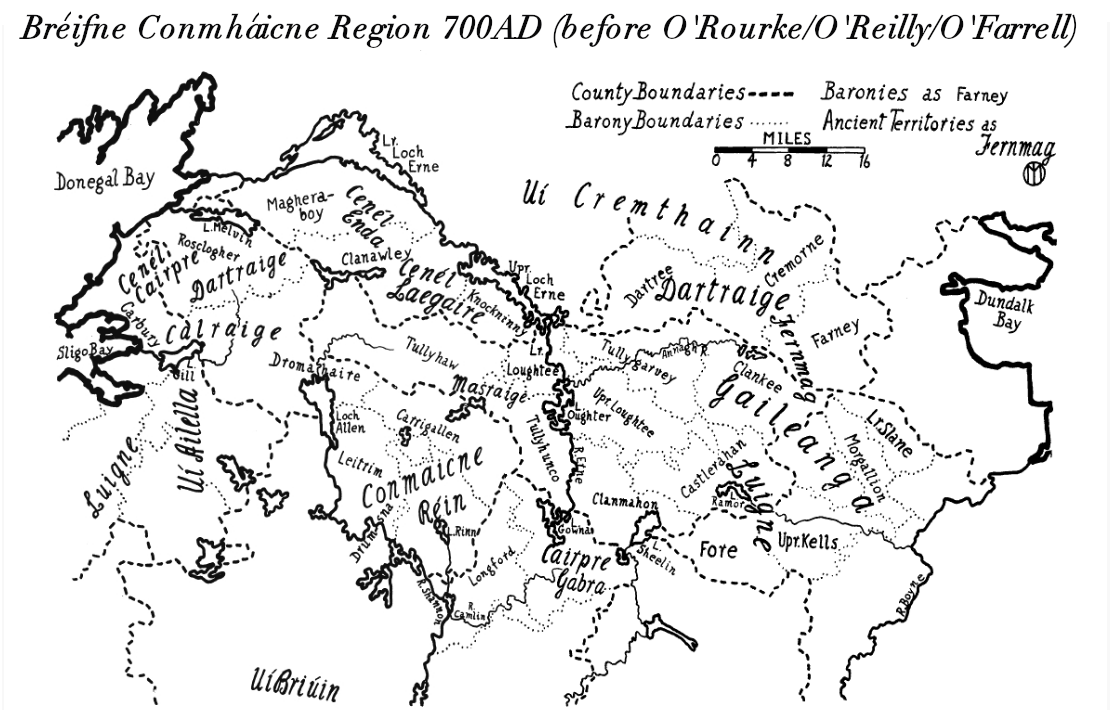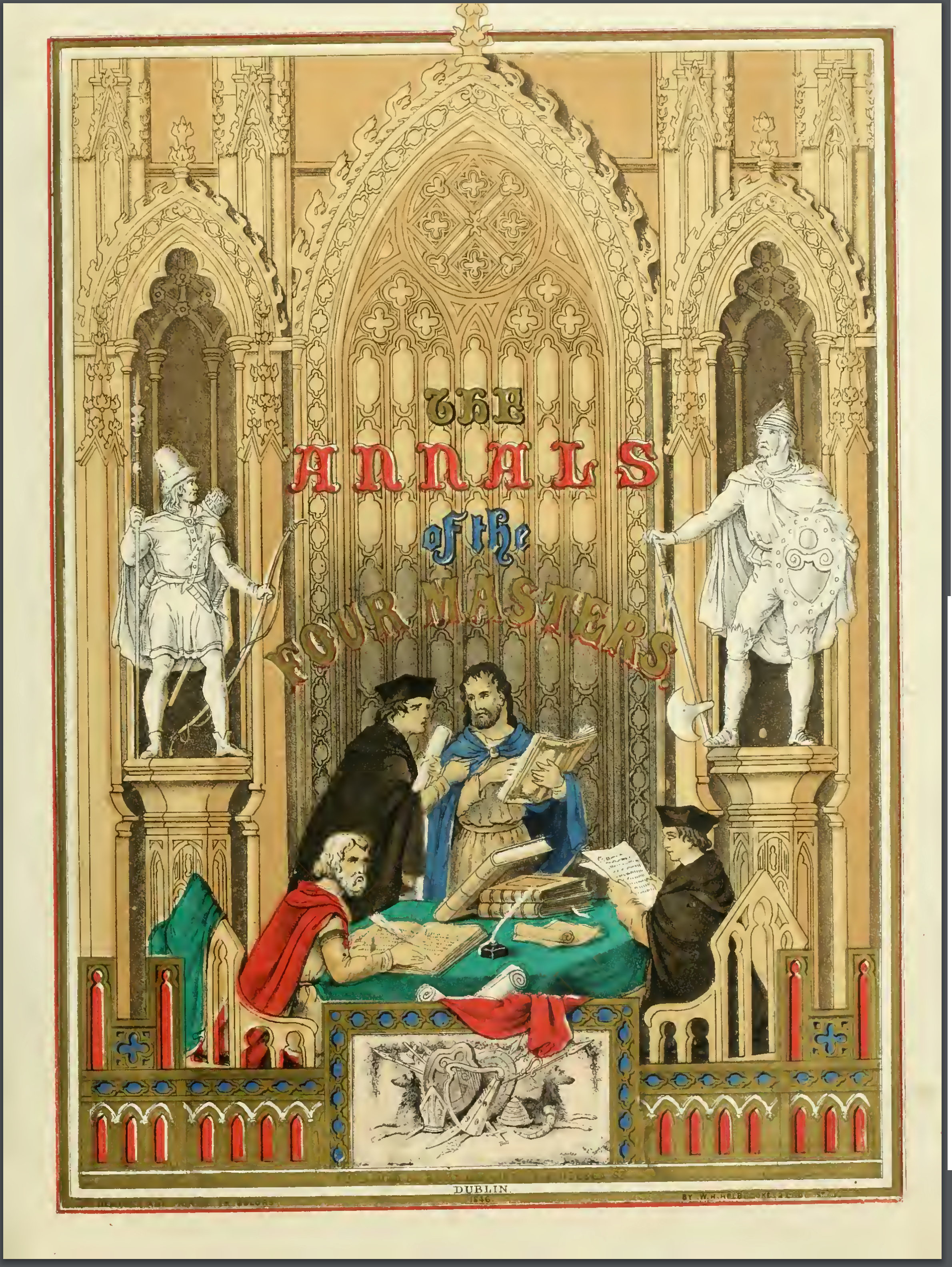|
Giolla Íosa Mág Samhradháin
Giolla Íosa Mág Samhradháin, (died 1231) was chief of the McGovern Clan and Baron or Lord of Tullyhaw barony, County Cavan from about 1181 to 1231. Ancestry His ancestry was Giolla Íosa Mág Samhradháin son of Giolla na Naomh Mág Samhradháin, the First, son of Muireadhach Mág Samhradhán who was the son of Samhradhán mac Conchobhar mac Fearghal mac Flann mac Aonghus mac Conchobhar mac Tadhg Tir mac Ruarc mac Íomhaor mac Cosgrach mac Dúnghal mac Oireachtach mac Eochaidh (Teallach n-Eachach or Tullyhaw is named after the latter). Description Poem 2, stanza 7, by Giolla Pádraig mac Naimhin, written c.1290-1298, in the Book of Magauran describes Giolla Íosa as ''white-chested Giolla Íosa''. Death His death is noted in the Irish Annals for 1231 and this is the first time there is a specific mention of a McGovern chief in the Annals, which implies that the clan first became of regional importance under the rule of Giolla Íosa. The Annals of the Four Masters 1231 st ... [...More Info...] [...Related Items...] OR: [Wikipedia] [Google] [Baidu] |
McGovern
McGovern may refer to the following: * McGovern (name), surname of Irish origin * McGovern Institute for Brain Research People: * Alison McGovern (b. 1980), British Labour politician * Barry McGovern, Irish Actor * Bill McGovern (American football) (1962–2023), American football coach * Brian Magauran b.1592 was chief of the McGovern Clan of Tullyhaw, County Cavan from 1622 until his death. * Brian Mág Samhradháin (anglicised McGovern), chief of the McGovern Clan of Tullyhaw, County Cavan from c.1240 to 1258. * Brian 'Breaghach' Mág Samhradháin (anglicised McGovern), chief of the McGovern Clan of Tullyhaw, County Cavan from 1272 to 3 May 1294. * Brian Óg Mág Samhradháin (anglicised Brian McGovern Junior) d. 1584, was chief of the McGovern Clan of Tullyhaw, County Cavan until his death in 1584. * Brian McGovern (footballer), former Irish professional footballer * Colonel Bryan Magauran, the Sixth, (Gaelic- Brian Mág Samhradháin) was the last chief of the McGovern ... [...More Info...] [...Related Items...] OR: [Wikipedia] [Google] [Baidu] |
Baron
Baron is a rank of nobility or title of honour, often Hereditary title, hereditary, in various European countries, either current or historical. The female equivalent is baroness. Typically, the title denotes an aristocrat who ranks higher than a lord or knight, but lower than a viscount or count. Often, barons hold their fief – their lands and income – directly from the monarch. Barons are less often the vassals of other nobles. In many kingdoms, they were entitled to wear a smaller form of a crown called a ''coronet''. The term originates from the Late Latin, Latin term , via Old French. The use of the title ''baron'' came to England via the Norman Conquest of 1066, then the Normans brought the title to Scotland and Southern Italy. It later spread to Scandinavian and Slavic lands. Etymology The word '':wikt:baron, baron'' comes from the Old French , from a Late Latin "man; servant, soldier, mercenary" (so used in Salic law; Alemannic law has in the same sense). The sc ... [...More Info...] [...Related Items...] OR: [Wikipedia] [Google] [Baidu] |
Lord
Lord is an appellation for a person or deity who has authority, control, or power (social and political), power over others, acting as a master, chief, or ruler. The appellation can also denote certain persons who hold a title of the Peerage of the United Kingdom, peerage in the United Kingdom, or are entitled to courtesy titles. The collective "Lords" can refer to a group or body of Peerages in the United Kingdom, peers. Etymology According to the ''Oxford Dictionary of English'', the etymology of the word can be traced back to the Old English language, Old English word ''hlāford'' which originated from ''hlāfweard'' meaning "loaf-ward" or "bread-keeper", reflecting the Germanic tribes, Germanic tribal custom of a Germanic chieftain, chieftain providing food for his followers. The appellation "lord" is primarily applied to men, while for women the appellation "lady" is used. This is no longer universal: the Lord of Mann, a title previously held by Elizabeth II, the Queen o ... [...More Info...] [...Related Items...] OR: [Wikipedia] [Google] [Baidu] |
Tullyhaw
Tullyhaw (, which means 'the Territory of Eochaidh', an ancestor of the McGoverns, who lived ) is a Barony in County Cavan in Ireland. The area has been in constant occupation since pre-4000 BC. Located in the northwest of the county, it has been referred to as Cavan's panhandle. Tullyhaw was originally a ''túath'' within West Bréifne. It was later absorbed into East Bréifne in the sixteenth century. Glangevlin.com: History - The Kingdom Of The McGoverns. https://www.glangevlin.com/2021/05/13/the-kingdom-of-the-mcgoverns/ In 1579, East Bréifne, then part of Connacht, was made a shire. The shire was named County Cavan, being named after Cavan (), the area's main town. The administration remained in the control of the local Irish dynasty and subject to the Brehon and Canon Law. In 1584, Sir John Perrot formed the shire into a county in Ulster. It was subdivided into seven baronies: *two of which were assigned to Sir John O'Reilly and *three to other members of th ... [...More Info...] [...Related Items...] OR: [Wikipedia] [Google] [Baidu] |
County Cavan
County Cavan ( ; ) is a Counties of Ireland, county in Republic of Ireland, Ireland. It is in the Provinces of Ireland, province of Ulster and is part of the Northern and Western Region. It is named after the town of Cavan and is based on the historic Gaelic Ireland, Gaelic territory of East Breifne, East Breffny (''Bréifne''). Cavan County Council is the Local government in the Republic of Ireland, local authority for the county, which had a population of 81,704 at the 2022 census. Geography Cavan borders six counties: County Leitrim, Leitrim to the west, County Fermanagh, Fermanagh to the north, County Monaghan, Monaghan to the north-east, County Meath, Meath to the south-east, County Longford, Longford to the south-west and County Westmeath, Westmeath to the south. Cavan shares a border with County Fermanagh in Northern Ireland. Cavan is the 19th largest of the 32 counties in area and the 25th largest by population. The county is part of the Northern and Western Region, a ... [...More Info...] [...Related Items...] OR: [Wikipedia] [Google] [Baidu] |
Muireadhach Mág Samhradhán
Muiredach (Old Irish), Muireadhach or Muireach, anglicized variously to Murdoch, Murtagh, Murray, Murdac, Mordacq and other forms, is a Goidelic name (meaning "chieftain") popular in Scotland and Ireland in the Middle Ages: * Muiredach Bolgrach, mythological Irish king * Muiredach Tirech, legendary high-king of Ireland * Muiredach mac Eógain (died 489), legendary early king of Ailech * Muiredach Muinderg (died 489), legendary king of the Ulaid * Muiredach of Killala, reputed early Irish saint * Muiredach Muillethan (died 702), king of Connaught * Muiredach mac Ainbcellaig (died c. 770), king of Dál Riata * Muiredach mac Murchado (died 760), king of Leinster * Muiredach mac Brain (died 818) (8th-century–818), king of Leinster * Muiredach mac Ruadrach (8th-century–829), king of Leinster * Muiredach mac Eochada (died 839), king of the Ulaid * Muiredach mac Brain (died 885), king of Munster * Muiredach mac Eochocáin (died 895), king of the Ulaid * Muireadhach Ua Carthaigh ( ... [...More Info...] [...Related Items...] OR: [Wikipedia] [Google] [Baidu] |
Samhradhán
Samhradhán, son of Conchobhar, was the progenitor and chief of the McGovern Clan and Baron or Lord of Tullyhaw barony, County Cavan from c.1082 to c.1115. The clan is named after him, Mág Samhradháin, meaning ''the son of Samhradhán''. Ancestry His ancestry was Samhradhán mac Conchobhar mac Fearghal mac Flann mac Aonghus mac Conchobhar mac Tadhg Tir mac Ruarc mac Íomhaor mac Cosgrach mac Dúnghal mac Oireachtach mac Eochaidh (Teallach n-Eachach or Tullyhaw is named after the latter). Description Poem 2, stanza 9, by Giolla Pádraig mac Naimhin, written c.1290-1298, in the Book of Magauran describe Samhradhán as ''bright and noble''. Residence Samhradhán lived in Moneensauran townland, Glangevlin, County Cavan. The townland is named after him (). There are three medieval ringforts in the townland, one of which was probably his residence.Site numbers 993, 994 & 995, p. 126 in ''Archaeological Inventory of County Cavan'' by Patrick O’Donovan, 1995 It is thus the cradle of ... [...More Info...] [...Related Items...] OR: [Wikipedia] [Google] [Baidu] |
Annals Of The Four Masters
The ''Annals of the Kingdom of Ireland'' () or the ''Annals of the Four Masters'' () are chronicles of Middle Ages, medieval Irish history. The entries span from the Genesis flood narrative, Deluge, dated as 2,242 Anno Mundi, years after creation to AD 1616. Publication delay Due to the criticisms by 17th-century Irish historian Tuileagna Ó Maol Chonaire, the text was not published in the lifetimes of any of the participants. Text The annals are mainly a compilation of earlier annals, although there is some original work. They were compiled between 1632 and 1636, allegedly in a cottage beside the ruins of Donegal Abbey, just outside Donegal (town), Donegal Town. At this time, however, the Franciscans had a house of refuge by the River Drowes in County Leitrim, just outside Ballyshannon, and it was here, according to others, that the ''Annals'' were compiled. [...More Info...] [...Related Items...] OR: [Wikipedia] [Google] [Baidu] |
Annals Of Loch Cé
The ''Annals of Loch Cé'' (also ''Annals of Lough Cé'') cover events, mainly in Connacht and its neighbouring regions, from 1014 to 1590. It takes its name from Lough Cé in the kingdom of Moylurg - now north County Roscommon - which was the centre of power of the Clan MacDermot. In the sixteenth century, King Brian MacDermot commissioned the Annals of Loch Ce, which remain among the most important written records of medieval Irish history.Inside a Medieval Gaelic Castle, Jarrett A.Lobell, Archaeology, p.26, March, April 2020 issue. For its earliest centuries it used, among others, the Annals of Boyle. The largest part of the Annals are attributed to members of Clan Ó Duibhgeannáin, with some emendations by the patron, Brian na Carraige MacDermot, first MacDermot of the Carrick (died 1592). The text is in Early Modern Irish, with a portion of the text in Latin. 4 December 2021 the tradition of Irish Annals writing was revived by a calligrapher, scribe and paper/ ink m ... [...More Info...] [...Related Items...] OR: [Wikipedia] [Google] [Baidu] |
Annals Of Connacht
The ''Annals of Connacht'' (), covering the years 1224 to 1544, are drawn from a manuscript compiled in the 15th and 16th centuries by at least three scribes, all believed to be members of the Clan Ó Duibhgeannáin. The early sections, commencing with the death of King Cathal Crobdearg Ua Conchobair of Connacht, are exceptionally detailed and give a good account of Connacht affairs during the 13th and early to mid-14th century, particularly for the families of O'Conor and Burke. The accounts however become more desultory, especially for the 16th century. Nevertheless, it is an invaluable document relating much that would have otherwise remained utterly obscure or unknown in the history of Connacht, and Ireland in general. A comparison between it and the '' Annals of Clonmacnoise'' reveal a common source, or perhaps one is a partial copy of the other. See also * Irish annals References * External links The Annals of Connacht [...More Info...] [...Related Items...] OR: [Wikipedia] [Google] [Baidu] |


